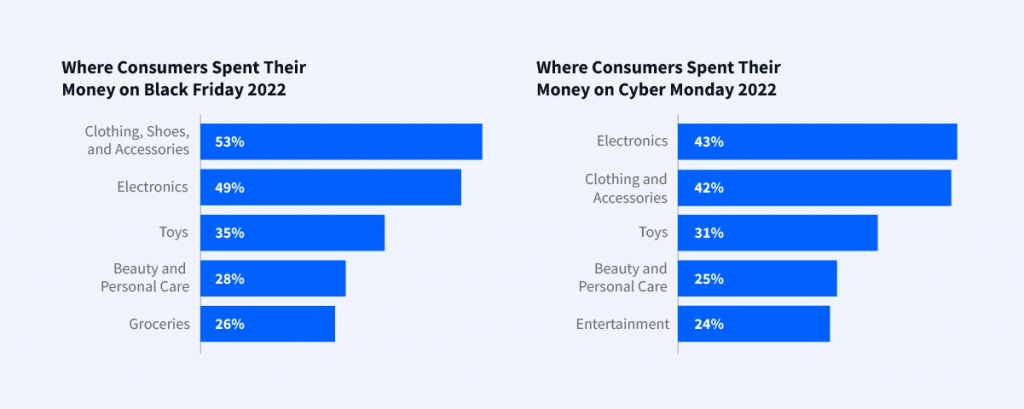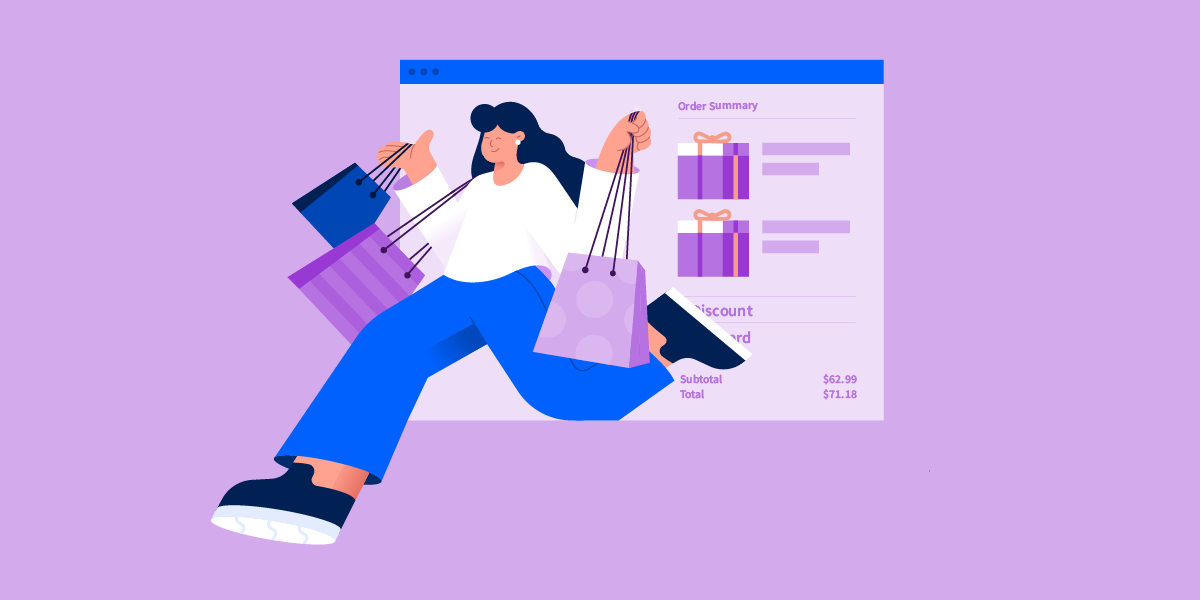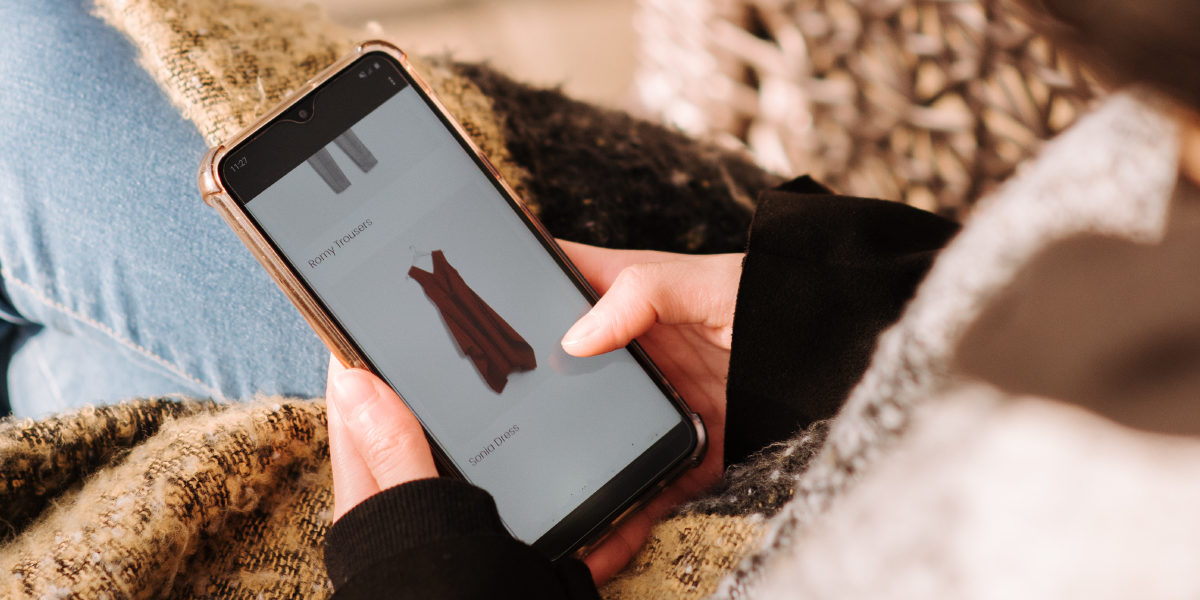Black Friday and Cyber Monday are shopping events with growing relevance, making them two events worth building a seasonal marketing strategy for. Black Friday has historically been known for brick and mortar sales, whereas Cyber Monday is considered the day that businesses promote their e-commerce sales. Black Friday and Cyber Monday originated in the US, but the shopping event is becoming increasingly popular around the world.
Black Friday and Cyber Monday Trends
Looking at historical data is beneficial to planning programmatic campaigns that perform, but this is especially true for seasonal campaigns like Black Friday and Cyber Monday.
Below, we’re sharing some of the biggest takeaways from Black Friday and Cyber Monday 2022. According to NIQ survey data, despite the pressure of rising inflation, people still participated in Black Friday and Cyber Monday in a big way. The below insights can help predict what the 2023 season might look like, and the consumer mindset around Black Friday and Cyber Monday.
- During 2022’s Black Friday and Cyber Monday shopping period, it was expected that record inflation and concerns about a looming recession would impact sales. But consumers shopped despite this. Shoppers spent a record amount both in brick and mortar stores and online.
- Consumers in 2022 cited two specific reasons for shopping on Black Friday and Cyber Monday. Most consumers shopped to “find gifts for other people” and “get some good deals.”
- In 2022, there was a significant overlap between Black Friday and Cyber Monday purchases. About two-thirds of Cyber Monday respondents also shopped on Black Friday. It was also found that the top three purchase categories were the same across both days: Electronics, clothing, shoes, accessories, and toys.
- In 2022, US consumers took the most advantage of Black Friday deal prices on traditional gifting categories (more so than early holiday deal days). Groceries and everyday essentials still had a strong presence on shopping lists. On Cyber Monday, traditional gifting items dominated shopping carts.
6 Black Friday and Cyber Monday Digital Marketing Strategies
Ready to start planning your Black Friday and Cyber Monday campaigns? Here are 6 strategies to get you started.
1. Plan Your Black Friday and Cyber Monday Strategy in Advance
Seasonal marketing events can sneak up on you! To make the most of your marketing efforts around Black Friday and Cyber Monday, start planning your campaigns well in advance.
An important part of planning for these shopping events is understanding when your campaigns should launch. Holiday campaigns typically start weeks before key dates, like Black Friday and Cyber Monday. Understanding when consumers are in the buying mindset, or starting to think about upcoming sales, allows you to get your campaigns ready in time for those receptive moments.
Other key aspects of planning your Black Friday and Cyber Monday marketing strategy are building customer profiles for your ideal audience. Your shoppers can span across various demographics, so understanding who they are in detail will benefit your seasonal campaigns.
Customer profiles describe everything you need to know about a specified group of customers. You can leverage that information to create a seasonal marketing strategy that aligns with the wants and needs of your audience. A customer profile will help you make informed decisions about campaign messaging, creative and channels, and which targeting tactics to use.
2. Leverage Historical Data to Inform Your Strategy
Another important aspect of planning Black Friday and Cyber Monday campaigns is looking at historical data to uncover patterns.
Reviewing your prior Black Friday and Cyber Monday ad campaigns can give you insights into current trends, and what products or services to focus your new campaign around. For the most relevant insights, look at data from the previous two years.
Another great source of data is to look at general consumer trends. These insights can help you understand what products or services will best perform during a specific seasonal event, and also provide insight into how consumers are shopping.
For example, the below data from Nielson shows which retail categories US-based consumers spent money on in 2022.

3. Leverage Storytelling in Your Marketing
Seasonal campaigns often revolve around events that are meaningful to consumers. For example, Mother’s Day and Father’s Day are all about celebrating parental figures. Black Friday and Cyber Monday tap into the holiday spirit. Because these shopping events occur at the start of the holiday season, many consumers view them as an opportunity to kick off their holiday shopping for loved ones.
Given this, don’t underestimate the power of storytelling for your Black Friday and Cyber Monday campaigns because it’s proven to spur emotion. One way you can spark emotion with your Black Friday and Cyber Monday campaigns is to leverage video advertising. With the combination of audio and visual elements, you can create video ads that not only spur emotion, but are memorable to viewers.
Whether your campaign tells a story that your audience relates to, or a story that just makes them laugh, the fact that it spurred emotion creates a starting point for the shopper to have an emotional connection with your brand–and think about your brand when those two big shopping days are coming up.
4. Build Anticipation For Black Friday and Cyber Monday Sales
Leveraging interactive creative ad formats for your Black Friday and Cyber Monday marketing will help you capture attention from your target audience and build awareness for your brand.
Interactive ads invite users to perform an action in order to have something revealed within the ad itself, or to navigate towards a specific landing page.
The action could be to hover over the ad, or it could be to click on something. This interactive viewer experience is the perfect way to uplift and complement your larger holiday marketing strategy, but it can also be used to alert consumers about your best Black Friday and Cyber Monday sales.
Shoppable video is another notable ad format for Black Friday and Cyber Monday campaigns because it showcases products while allowing a user to browse right in the banner. With this ad format, you can reduce the steps that a user has to take between awareness and conversion.
During Black Friday and Cyber Monday, dynamic countdown ads are particularly useful because they can be leveraged to inform or remind users about your sales. And, a dynamic countdown unit will help create a sense of urgency for your audience to purchase. If your Black Friday sales are only lasting 24 hours, a dynamic countdown ad can make sure your audience doesn’t miss out.
5. Leverage Contextual Targeting to Reach the Right Audience
Contextual advertising is a cookieless targeting methodology that leverages content rather than user data to reach the right audience, at the right time. With this targeting tactic, targeting is based on content. This enables you to connect with consumers who are receptive to the messaging of your ad.
Aligning ads with relevant content leads to a more personalized experience for your audience. For example, with contextual targeting, a person browsing a blog about the best holiday gifts for their mom might be served an ad for a Cyber Monday flash deal for a gift that mom would love.
6. Dynamically Retarget Users Who Have Shown Interest
In today’s programmatic advertising landscape, most users need to encounter your ads several times before they are likely to convert.
Retargeting campaigns are a great strategy for re-engaging consumers who have already shown interest, by serving them a relevant message. By reaching a user repeatedly, the effort needed to win their conversion is a little less than consumers who haven’t engaged with you.
Dynamic retargeting is a particularly great tool for Black Friday and Cyber Monday. You’re able to serve an ad that shows a product a user has looked at before–this time with the sale price. This personalized ad reminds the user about that product or service, encouraging further engagement and brand recall.
To leverage retargeting for Black Friday and Cyber Monday marketing, it’s important to start your campaign early, so there’s time to build up a retargeting pool. Then, retarget those users close to Black Friday and Cyber Monday (or on those exact dates) to entice them to take advantage of a sale.
Reach Your Black Friday and Cyber Monday Goals
Measuring the performance of your Black Friday and Cyber Monday campaigns is crucial for understanding which touch points in your marketing funnel are generating the most value.
Programmatic campaign reporting will be your map to success! It gives you access to data that will help you make adjustments to your Black Friday and Cyber Monday campaigns based on performance. And, you can leverage the same data for planning future campaigns.
Want to create exceptional Black Friday and Cyber Monday campaigns? Request a demo to learn more about StackAdapt.
Black Friday and Cyber Monday FAQs
Black Friday and Cyber Monday are the two biggest shopping days of the year, which kick off the holiday season. Black Friday is the day after Thanksgiving (US), and Cyber Monday falls on the following Monday. Many stores offer highly promoted sales and discounted prices on these two days.
BFCM is an acronym that stands for Black Friday, Cyber Monday. Marketers often use this acronym to refer to this anticipated sales event, which happens online and in-store to kick off the holiday shopping season. Black Friday comes up on the Friday after Thanksgiving (US), and Cyber Monday is the following Monday.



